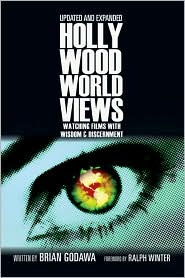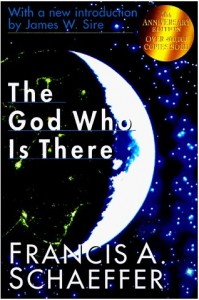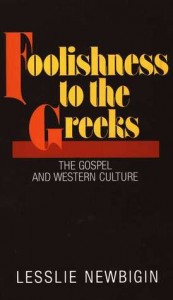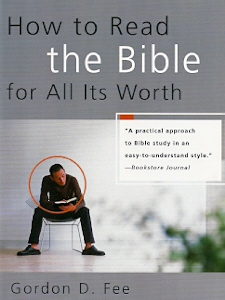By Cris Putnam in association with Apologetics 315
 Hollywood Worldviews: Watching Films with Wisdom & Discernment by Brian Godawa, Downers Grove, IL: InterVarsity Press, 2002, 210 pages, $9.99 kindle edition.
Hollywood Worldviews: Watching Films with Wisdom & Discernment by Brian Godawa, Downers Grove, IL: InterVarsity Press, 2002, 210 pages, $9.99 kindle edition.
Brian Godawa is a professional screen writer with successful movies like To End All Wars, The Visitation, and Change Your Life to his credit. He is also an evangelical Christian with a passion for teaching biblical discernment in regard to films. He writes that “God loves movies”[1] because seventy percent of the Bible is communicated through creative genres like narrative, stories and poems. It follows that God uses drama as a powerful means to teach truth. It also follows that the secular world uses them to promote a different agenda. Whether one is aware of it or not entertainment mediums are promoting a worldview. Accordingly, Christians should cultivate a sophisticated understanding of how those mediums are employed in our culture. Godawa states his goal succinctly, “to help the viewer discern those ideas that drive the story to its destination and see how they influence us to live our lives-to understand the story behind the story.”[2] He examines two equal but opposite errors: cultural desertion (anorexia) and cultural immersion (gluttony). The book is divided into three sections Act 1: Storytelling in Movies, Act 2: Worldviews in Movies, and Act 3: Spirituality in Movies. The paper will attempt to show that the book is valuable for developing a discerning eye.
In dealing with objectionable content like sex and violence, an important point is it is the context of the material that determines its status. For example, gratuitous violence celebrating a nihilistic worldview is much more offensive than the same violence depicted in a just war. He cites narratives from the book of Judges as potent examples of horrendous conduct unabashedly presented in the Bible (e.g. Judges 19). He provides a thorough cataloging of R rated images and devices in the Old and New Testaments inferring that in the right context, such material is not out of bounds for Christian consumers. He argues, “If we ignore truth’s darker side, we are focusing on half-truths, and there are no fuller, more complete lies than half-truths.”[3] Our opinion should be based on context; we need ask what it the author’s intent? In way of summary, content is evaluated by four factors: 1) intent (is it exploitive?); 2) depiction (is it gratuitous?); 3) consequences (is evil affirmed?); 4) context (as exemplified by the Bible, context makes all the difference).
Chapter two asserts that movies are the mythology of American culture and that every story is informed by a worldview. Myth, in this sense, is a story which seeks to explain the big questions people ask. For example, the superhero genre is modernization of the heroes of old like Odysseus. Some, like Superman, make allusions to the Bible, while others subvert the genre and present tragically flawed characters like The Dark Knight. Next, Westerns are discussed as a reinforcement of the American ideal of the rugged individual. Godawa reveals that, “movies are one of the most effective means of communicating mythology because they are a story-centered medium that captures and reflects our deeply held beliefs.”[4] Hollywood is particularly fond of Joseph Campbell’s construction of the Hero “monomyth” loosely based on Jungian psychology. Whereas secularists might attempt to explain the biblical stories as merely one myth among many, Godawa, like C.S. Lewis, argues that Christianity is the underlying truth behind the monomyth. God is the ultimate storyteller and all other myths are necessarily derivative.
Chapter three tackles the major elements of a movie. The first is the theme, what the story is all about or the “moral” of the story. Godawa asserts that most movies have a redemptive theme similar to a Christian testimony albeit many are self-actualized. The hero and his goal is the next major element. The adversary opposes the hero’s goal. Accordingly, this foe usually has a conflicting worldview to the hero. A typical plot line will showcase a tragic character flaw in the hero and an apparent defeat at the hands of the adversary. This results in the hero “running the gauntlet” and after a moment of truth coming face to face with the adversary. This forces the hero to a moment of self-reflection emphasizing the conflicting worldviews while promoting the one the author holds dear. The resolution is the final element which shows the heroes redemption or, in some cases, tragic consequence. While movies are about the story and stories are mostly about redemption, different worldviews place their philosophical spin on the meaning of redemption entailing “the recovery of something lost or the attainment of something needed.”[5] Understanding the craft of story allows the viewer to discern the writer’s values.
Act two of the book deals with philosophical movements and how they have informed the themes of modern movies. The first is existentialism which fuels three main themes: 1) chance over destiny; 2) freedom over rules and 3) action over contemplation.[6] The former is based on enlightenment rationalism and denies any sort of divine providence or destiny. This theme, including titles like Forrest Gump, Being There, and Grand Canyon, elevates chance as driving force of the universe. Life is represented as ultimately absurd. Pleasantville is a film about freedom over rules and Alexander is representative of action over contemplation. These reveal how existentialist worldviews rebel against rules and elevate experience over thought. From Woody Allen’s dark nihilism to the Nietzschean “morality” fable, Godawa shows how existentialism in ubiquitous in popular movies. While they have much in common, the existentialist favors individualism but the postmodernist favors the collective.
Postmodernists question all claims to objective universal knowledge. Accordingly they necessarily deny God’s story revealed in scripture as an oppressive metanarrative. While atheistic versions deny the existence of truth, there are Christian postmodernists who deny the knowledge of truth by questioning biblical interpretation (e.g. Brian McClaren, Rob Bell). The postmodernist holds that reality is a social construct of language. Movies like The Invasion, The Dark Knight and Pulp Fiction are promoting the postmodern worldview. These sorts of movies subvert absolutes, blend good and evil and question everything by fusing fantasy and reality or confusing the two. The fusion of fantasy and reality (e.g. Who Framed Roger Rabbit, Moulin Rouge) works on the premise that because a movie cannot possibly be about objective reality (which can’t be known) then the story is really about the story. The confusion of the two (e.g. The Matirx, Blade Runner, Fight Club) employ a real / artificial motif correlating to postmodern denial of ultimate reality replaced by social construction. Accordingly, deconstructive techniques such as the nonlinear timelines in Pulp Fiction (even working backwards) are often used in postmodern films. Because of postmodernism’s pervasiveness and undermining of the Gospel, this discussion is one of the most important in the book.
Chapter six covers a lot of ground quickly by addressing five philosophical themes: romanticism, monism, evolution, humanism and Neo-paganism in the movies. Romanticism is characterized in terms of a revolt against the enlightenment and a predecessor to existentialism. Examples of movies espousing a romantic worldview are Titanic, Meet Joe Black, A Time to Kill, and Finding Neverland. Godawa astutely observes that secular romanticism elevates the creation over the creator because it tends to, “to ignore God but maintain transcendence by hijacking the language and concepts of religious faith and substituting creativity and imagination for the deity.”[7] Even so, C.S. Lewis and J.R. Tolkein are examples of Christians who write in the Romantic genre. Second, monism, usually associated with Eastern religion, is the belief that reality is ultimately one. The pantheistic ideal is that all religions are pointing to the same God. Movies that promote monism are Powder, Phenomenon and I Heart Huckabees. Third, evolution, as the overarching creation myth of secular society, features prominently in many movies. Interestingly, the Darwinian worldview often shows up overtly as a “survival of fittest” ethos with no overt reference to natural science. More troublesome are the moral implications as discussed in reference to Kinsey, a film about the infamous sex researcher. Fourth, humanism is defined as an anti-supernatural worldview that “considers redemption to be found in our own humanity through science and human reason.”[8] Fifth, Neopaganism is openly hostile to Christianity as well albeit from a supernatural point of view. Final Fantasy: The Spirits Within, The Cell and Chocolat are neo-pagan apologetics films. These many examples dispel the notion of mindless entertainment.
Act three is a discussion of spirituality in film. First, various portrayals of Jesus are surveyed and evaluated in terms of coherence to the New Testament. Jesus Christ Superstar and The Last Temptation of Christ are examples of postmodern deconstructionism. This entails Jesus being reduced to a fallible human and the miraculous explained away as superstition. In this regard, Hollywood’s penchant for Campbell’s mythic Hero archetype is foundational. Accordingly, Godawa charts the movie The Matrix revealing an astonishing degree of similarity to the Gospel narrative. While The Jesus Film and The Passion get high marks, there is an extended discussion of the latter with its scandalous violence and Catholic overtones. Chapter eight explores various ways Christianity is portrayed.
Unfortunately, the liberal postmodern worldview portrays Christians stereotypically as repressed, hypocritical and dangerous. As a virtual apologetic for sin, biblical faith is presented as an antidote to everything fun and life affirming. This very pervasive agenda is displayed in movies like The Cell, Pleasantville, The Mist and Saved! Also, The Da Vinci Code is transparently hostile with its absurd inference to Jesus’ marriage and fathering of children. Similarly, in spite of redeeming qualities, Gladiator can be viewed as pagan apologetics. Nevertheless, there are movies like Les Miserables which display a positive redemptive Christian message. Even Pulp Fiction showcases biblical redemption in the midst of its celebration of underworld depravity. In many films, the concept of fate serves as a God substitute. In the end, Godawa concludes that it is the movies that ignore God as if He didn’t matter that are the most subversive; those that criticize Him, at least acknowledge His relevance. This leads to chapter nine’s discussion of faith.
Godawa briefly reviews the philosophical history leading to the fact / value divide and faith being redefined as a blind leap. Quite a few films promote this false definition of biblical faith but particularly amusing is O Brother, Where Art Thou? where the charge of an existential leap is leveled at the empiricist. Accordingly, the Everett character is portrayed as willfully ignorant concerning the many miracles he experiences to the point of absurdity. In another odd reversal, Contact deconstructs the search for alien life into a faith commitment. Faith in oneself with its theme of the individual against the system is an American favorite. “Faith verse doubt” is another popular plot line. In this category, a film called The Body centers on the alleged discovery of Jesus’ bones by Vatican archeologists with its ensuing cognitive dissonance. Authentic biblical faith defined as “trust based on evidence” rather than “belief without (or in spite of) evidence” is seldom seen in film. A chapter on spiritual warfare concludes act three.
Movies with supernatural themes are very popular and perhaps speak to man’s universal need for transcendence. Godawa takes a few shots at end time’s movies like Left Behind for speculating about current events and prophecy. This seems suggestive of a disdain for futurist dispensationalism telegraphed back in chapter 1 with the inference that the great harlot in Revelation 17 is “most likely Israel.”[9] This exegesis is suspect given that verse 18 seemingly identifies her as Rome, undoubtedly the hands down favorite for “the great city that has dominion over the kings of the earth” when John wrote the Apocalypse at the height of the Pax Romana. That aside, movies about exorcism, angels and demons are cogently discussed. One particularly strong criticism is how many films falsely portray Satan as God’s equal ruling as a king in Hell which is more akin to dualistic religions like Zoroastrianism. In truth, Satan is a defeated foe who will be punished in Hell at the return of Christ. Because Hell is offensive to non-believers, various notions of works based salvation, reincarnation and karma dominate the movies. Another keen observation is that even though most of the theology in these kinds of movies is lacking they often do inspire discussion and a curiosity for biblical truth.
The final section, denouement, is a strength of the book that the reader will want to refer back to time and time again as she watches new films with eyes wide open. He recaps and summarizes while reminding us to avoid the extremes of cultural anorexia and gluttony. He encourages viewers to look for the good in movies as well as critiquing them. To that end, he lists some useful questions:
Is this an educational approach to exposing evil? What are the context and consequences of the vice portrayed? Is it dehumanizing or humanizing? Does the movie celebrate evil, or does it ultimately condemn it? Is the sin displayed as an end in itself, or is it a part of the bigger picture that leads to redemption? Does the movie go overboard in detail, or is some detail necessary to emphasize the seriousness of our behavior?[10]
The key is to use discernment while cultivating appreciation for the artistic elements. He cites Paul’s appropriation of pagan philosophers in his Areopagus sermon as a model for discussions. Accordingly, movies are a fruitful muse for discussions of spiritual matters with friends and relatives. He suggests three subjects areas: 1) the craft; 2) the story; 3) the worldview. A winsome and tactful approach to discussing films can lead to successful evangelism.
This review offered a summary and analysis of Hollywood Worldviews by Brian Godawa. In making a summary, the paper sought to illustrate the value of the book by discussing how the author explains the craft, the story and the worldview of various films. The author took great care to explain difficult philosophical and literary concepts in accessible language. The relationship between these points was shown. In the end, it seems that these points support the idea that culturally literate believers should make time to read this book.
[1] Brian Godawa, Hollywood Worldviews: Watching Films with Wisdom & Discernment. Kindle Edition (Downers Grove, IL: InterVarsity Press, 2002), Kindle Location 102.
[2] Godawa, Hollywood, Kindle Locations 118-119.
[3] Godawa, Hollywood, Kindle Locations 403-404.
[4] Godawa, Hollywood, Kindle Locations 657-658.
[5] Godawa, Hollywood, Kindle Location 154.
[6] Godawa, Hollywood, Kindle Locations 940-941.
[7] Godawa, Hollywood, Kindle Locations 1638-1639.
[8] Godawa, Hollywood, Kindle Locations 1785-1786.
[9] Godawa, Hollywood, Kindle Locations 391-392.
[10] Godawa, Hollywood, Kindle Locations 2818-2821.






